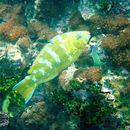Diagnostic Description
provided by Fishbase
This species is distinguished by the following characters: median predorsal scales 6-8 (usually 7); 3 scale rows on cheek, 1(6-7), 2(6-9), 3(3-5); pectoral-fin rays 13-15 (occasionally 15); terminal male usually with 2 conical teeth on side of upper dental plate (female without), with lips mainly covering the plates; caudal fin rounded in small female, with prolonged lobes in large adult. Colour of male dark reddish brown anteriorly with a bright green dot at top end of line from mouth through eye to top of opercular opening; female red on head, belly and fins, side with wavy black and white stripes, and dark green bands around the mouth and eye (Ref. 9793, 90102).
- Recorder
- Estelita Emily Capuli
Comprehensive Description
provided by Smithsonian Contributions to Zoology
Scarus ghobban Forskal
Scarus ghobban Forskål, 1775, p. 28.—Schultz, 1958, p. 84, pl. 16C, D; 1960, p. 248.—Kamohara, 1963, p. 15 [Japan].—Woodland and Slack-Smith, 1963, p. 45 [Heron Island].
Callyodon ghobban.—Smith, 1959, p. 279, pl. 43H.—Kamohara, 1960, p. 26.—Munro, 1967, p. 439, fig. 836 [New Guinea].
Pseudoscarus ghobban.—Gohar and Latif, 1961, pp. 97–126, figs. 1–10 [Red Sea; anatomy of alimentary tract]; 1961, pp. 127–146.
Scarus guttatus Bloch and Schneider, 1801, p. 294.—Schultz, 1958, p. 85, fig. 14, pl. 17A.
Callyodon guttatus.—Smith, 1949, p. 296, pl. 62: fig. 824.—Fourmanoir, 1957, p. 186, fig. 30 [Mozambique Channel].
Scarus maculosus Lacepède, 1802, pp. 5, 21, pl. 1: fig. 3.—Bauchot and Guibè, 1960, p. 295 [holotype no. 2478 in Paris Museum].
Scarus psittacus [not Forskål] Rüppell, 1828, pl. 20: fig. 1.
Scarus pepo Bennett, 1834, p. 28, fig. 28.
Scarus dussumieri Cuvier and Valenciennes, 1839, p. 252.—Schultz, 1958, p. 100, pl. 20B.
Scarus Scabriculus Cuvier and Valenciennes, 1839, p. 271.
Scarus hertit Cuvier and Valenciennes, 1839, p. 215.
Scarus reticulata Swainson, 1839, p. 226.
Scarus haridoides Bleeker, 1853, p. 344.
Scarus pyrrostethus Richardson, 1846 [1845], p. 262.
Pseudoscarus cantori Bleeker, 1862, p. 43, pl. 9: fig. 2.
Pseudoscarus californiensis Pellegrin, 1901, p. 163.
Scarus noyesi Heller and Snodgrass, 1903, p. 206, pl. 9.—Schultz, 1958, p. 91, fig. 18.
Pseudoscarus natalensis Gilchrist and Thompson, 1909, p. 259.
Pseudoscarus rostratus [not Poey, not Seale] Günther, 1909, p. 315, pl. 154.
Scarus garretti Günther, 1909, p. 306, pl. 153C.
Scarus pyrrostethus australianus Paradice, 1927, p. 103.
Scarus azureus Meek and Hildebrand, 1928, p. 742, pl. 72: fig. 1.—Schultz, 1958, p. 89, fig. 16.
Callyodon apridentatus Smith, 1956, pp. 10, 14, 19, pl. 44F; 1959, pp. 270, 278, 279, pl. 44F [large male of S. ghobban].
Callyodon pyrrhostethus.—Marshall, 1965, p. 323.
Characterized by 5 or 6 median predorsal scales, 3 rows of scales on cheek, with 1 to 3 scales in ventral row, ii,13 pectoral rays, rarely ii,12; lips not quite covering white teeth; background coloration light orange to yellowish, centers of scales marked with bright blue spots that are arranged to form 5 vertical bars separated by 1 to 3 yellow-orange or pale interspaces; vertical blue bars not always present. Dorsal and anal fins edged with narrow blue band and center of fins orange; anal with basal blue streak; blue streak from corner of mouth past lower edge of eye; edge of upper lip orange, that of lower lip green.
Schultz (1958) recognized two species of parrot-fishes that are closely related, S. ghobban and S. dussumieri. There is full agreement between Smith (1959) and Schultz (1958) on the identity of ghobban. The latter recognized S. dussumieri Cuvier and Valenciennes as distinct, and since the types of S. dussumieri have ii,13, rarely ii,12 pectoral fin rays, I agree with Smith (1959) that S. dussumieri is a synonym of ghobban, whereas S. dussumieri [not Cuvier and Valenciennes] Schultz, 1958 (p. 100, pl. 20A) is actually S. mus (Smith).
USNM 202642, a specimen 270 mm in standard length from the Mombasa fish market, Kenya (IIOE, Sta. FT–2, 15 November 1964), appears to be an example of Scarus apridentatus Smith, 1956 (also 1958, pl. 42F). Since this specimen is a male and is very close to S. ghobban in all respects except the vertical blue bars, I agree that S. apridentatus is the adult male of S. ghobban as suggested by Smith (1959). Schultz (1958, p. 51) referred S. apridentatus to the synonymy of S. harid because Smith’s illustration appeared to have only 4 median predorsal scales.
A recent examination of Plate 154 (Pseudoscarus rostratus Günther, 1909, p. 315) indicates 5 or 6 median predorsal scales, which removes this species from the synonomy of S. lunula, where Schultz (1958, p. 54) placed it. The color pattern suggests it is S. ghobban.
Since no specimen of S. guttatus Bloch and Schneider has been collected to establish the validity of this species, I tentatively follow Smith (1956) and refer it to S. ghobban as a synonym.
The following specimens were recently collected by the Anton Brunn (IIOE): From Mombasa Market, Kenya: Sta. FT–2, 16 November 1964, 2 spec, 235270 mm; USNM 202665 and 202689, Sta. FT–2, 16 November 1964, 2 spec, 235–420 mm. From Amirantes Island: USNM 202662, Sta. RS–41, KA–39, 8 December 1964, 1 spec, 205 mm; Sta. HA–19, 8 December 1964, 1 spec, 71 mm; USNM 202664, Sta. HA–16, 3 December 1964, Aldabra Island, 14 spec, 35–177 mm; Sta. FT–11, 30 Novembeer 1964, Dar-es-Salaam Market, 1 spec, 49 mm. Uncataloged from Diego Garcia Atoll; Sta. HA–67–16, 22 June 1967, 1 spec, 167 mm; Sta. HA–67–17, 23 June 1967, 1 spec. 290 mm.
The Te Vega collected the following: Sta. 21, at Tutuila Island, 19 August 1963, 2 spec, 75 and 86 mm; Sta. 57, at Halmahera, off Teluk Kau village, 26 September 1963, 1 spec. 159 mm.
RANGE.—Eastern, central and western Pacific Ocean, Indian Ocean, and Red Sea.
- bibliographic citation
- Schultz, Leonard P. 1969. "The taxonomic status of the controversial genera and species of parrotfishes with a descriptive list (family Scardiae)." Smithsonian Contributions to Zoology. 1-49. https://doi.org/10.5479/si.00810282.17

